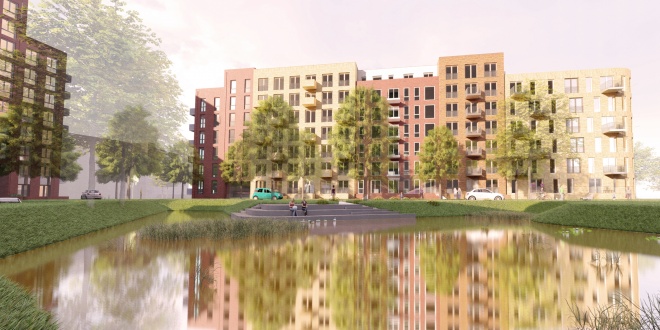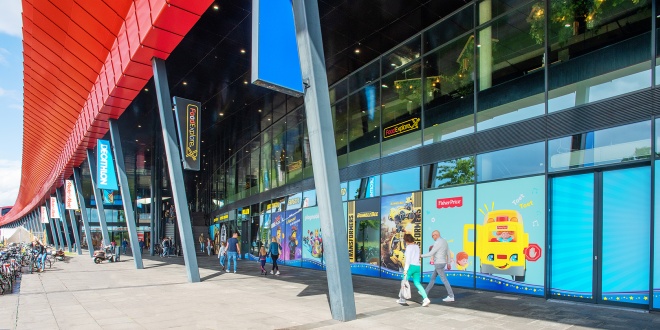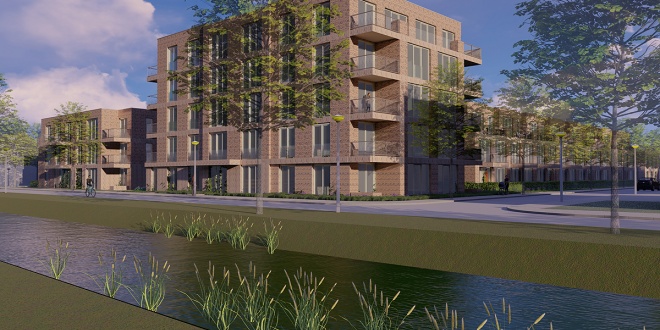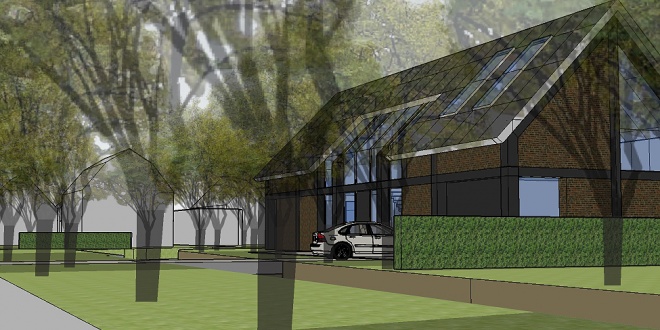The Rijneke Boulevard in Zoeterwoude is a busy shopping area with a dated appearance. The complex has its back to the Rijn. We have developed a vision to renovate and expand the boulevard in stages. The Rijn is also more involved in the shopping area by creating harbors.
The first phase starts on the west side of the complex. In this phase, the first building has already been renovated (completed in 2016) and the expansion of 6,000 m2 of retail space started in January 2018. The shopping area is organized around the old harbor of the Heineken factory, where the hops used to be unloaded.
On a triangular plot, where the historical Vlietweg diverts from canal the Vliet, VVKH designed a house based on experiencing the Vliet. Rough, brick walls engage each other, vaging what is inside and outside. Water and landscape are part of the house.
At the entrance you're being received in a yard with monumental trees. The aperture in the wall give a first glance of the Vliet. From the high entrance it's three steps up to enter the livingroom giving a panoramic view over the Vliet, but shielded from the road.The folding window opens completely and extents the livingroom straight to the edge of the water. A stair with cantilevered steps and a glass balustrade leads to the first floor.
Just south of Berkel & Rodenrijs a new fire station has been built to service the suburbs build between Rotterdam and The Hague. Because of the growing number of inhabitants in this region, a future extension is already taken into account in the design. The total plot is covered with a steel mesh in which all future extensions will fit. The façade is covered with corten steel plating wich create the desired sturdy look.
In 2003 a sturdy looking fire station was yielded. The building is located at the entrance of Amstelveen form highway A9 and shows the firetrucks ready for duty. The technical building on top of the rough base is used for offices, sleepingquarters and a gym. VVKH also designede the bridges crossing the water towards the building.
Woonboulevard Voorsterpoort in Zwolle is a well-running residential boulevard near the exit of the A28 motorway. Market research shows that there is room for expansion with more than 30,000 m² GFA for large-scale retail. Plots are available for expansion behind the existing boulevard. In our vision, the expansion will be realized around an oval square with parking at ground level. All shops are visible from anywhere on the square. Landmarks will be realized at the ends. The extension will be connected to the existing boulevard through a gate. The existing boulevard will be renovated, so that the shopping center will eventually again present itself as a cohesive complex. The plan can be realized in phases.
At the Duurstedelaan in Utrecht lies one of the most sustainable schools of the Netherlands. The school is centrally located in a reviving neighbourhood, in the south of Utrecht and accommodates three primary schools, a nursery and a broad programme of functions related to the school and local community. Future users participated from the start in the design-process. Different users gain with collaboration, but also want to be recognized and have their own specific needs. All functions are organised round a collective court space. The gym is constructed above this space and thus forms the roof of the court. The building is set up in red brickwork that is continued in the playground boundaries. The identity of the different schools is reflected in their own colour and pattern in het façade panelling and silhouette of the building-mass. The whole setup matches with the urban scale of the neighbourhood and blends in naturally.
The Kanaalpark is an office area along the Vliet on the south side of Leiden. Here, two apartment buildings are being built for starters.
Many offices in this area have long been vacant and the area looks messy and dated. The municipality of Leiden has challenged developers to take the initiative to transform the site into a high-quality living-work area. That glove is being picked up. Some offices are being converted into apartments, others are being demolished and replaced by residential buildings. Viable office owners are making a quality improvement. The municipality has drawn up an ambitious plan for the redesign of the public space.
Commissioned by the Leidse Vastgoed Maatschappij we have designed two apartment buildings for starters on the labor market. Block 1 with 88 apartments is being built on the site of an old office building. Block 2 with 41 apartments will be built on an existing parking lot. The buildings have been carefully integrated into the urban design and complete the structure of closed building blocks. Height accents are determined in conjunction with the environment. The blocks are architecturally parceled, in line with the already completed housing construction.
Home and Living Mall Ekkersrijt is located on the north of Eindhoven, directly at the highway A50. In 2013 the existing shopping mall (21.000 sq.mtrs) has been extensively renovated and expanded with 24.000 sqr.mtrs.
New look and feel
The existing building was outdated and made up of separate buildings, with closed unattractive facades and entrances, shop windows only facing the courtyard. Experience and length of stay have been central themes to the renovation and expansion. The new complex has been given a contemporary, modern feel. Old, loose components and constructions are forged into a recognizable, homogeneous unit, which is easily visible from the public road. In addition, a pleasant living environment has been created for visitors. The original stores remained open during this major redevelopment. With intensive consultation and coordination between designer, consultants, tenants and builder the inconvenience during the construction has been limited to a minimum. With this transformation the center has been made future-proof.
Renovation
Existing shops have been given new facades to meet with the requirements of present times and to become one with the extension. Besides facades also the roof has been thoroughly upgraded and installations (among others sprinkler system) have been replaced, modernized. Signing is carefully incorporated and nowhere predominant.
Extension
The new building has a distinctive façade of metal with a specifically, laser cut pattern. Recessed into the façade are the neon signs and the ramps to the parking deck. The movements of the cars on the ramps provides extra dynamism in a natural way.
On the former courtyard a freestanding oval new shop building is made. This building forms the heart of the new home and living mall and is, due to its special design, an icon to the highway and nearby. From the parking deck visitors reach the heart through walkways and they go with elevators and escalators to the open and indoor malls on the lower levels of the complex. Shops on the upper floors thereby have the same run as on the ground floor. Because of the oval building shopping at ground level has a pleasant scale with shops on both sides.
VVKH has been selected to design a primairy school at the Jazzsingel in Utrecht. The tough looking school is centrally located with a park as it's backyard. The classrooms are organised around an elips-shaped playroom for exercize, music and dance classes. The set backs in the side-facades allow each classroom a view to the park.
Next to the highway A2 near the centre of Utrecht a spectacular large scale shopping and leisure centre has been realised. The 800 meter long “Ferrari red” complex acts as a noise barrier to the new residential area of Leidsche Rijn. The fluent design of slowly undulating lines is inspired by the perspective of the driver passing the complex in 32 seconds, driving at a speed of 100 km/hour. The fluent lines create an illusion of movement. This building, having a surface area of approx. 65,000m2, houses many retail businesses, a high-quality DIY store, a catering business (fast-food restaurant) and leisure facilities (discotheque, sports or multi-purpose hall). On the roof is a 1400 spaces large car park. The building together with the ‘Cockpitgebouw’ at the Wetering Noord area, designed by the architect Kas Oosterhuis, are the showpiece of the city of Utrecht.
The urban plan for the city-centre of Zeist provides for necessary architectural interventions, but is mainly concerned with the quality of public space. Identified characteristics of Zeist have been projected on the city centre. By doing this the centre will be much greener and facades will be restored to what they used to look like. The urban plan defines three different shoppingzones, each with their own atmosphere and type of shops. By banning cars a continuous and compact shopping area with pleasant pedestrian streets emerges.
A big part of the urban plan is the redevelopment of the library. VVKH aims to reuse the building as much as possible. The building is less than 30 years old and apart from the closed facades it functions well. In the new design we make shoppingfacades on the ground floor, moving the library to a new part of the building. On top we planned 58 apartments with a shared garden. Reuse of the existing building may demand an extra effort, but offers a very sustainable sollution and saves on investments.
In the old wharf cellars at the intersection of the Oude and Nieuwe Rijn in the center of Leiden is the café restaurant "Annie's". We designed a curved floating terrace on behalf of the owner of the restaurant.
The Wall in motion
The Wall shopping center in Leidsche Rijn, located next to the A2, which also serves as a noise barrier, changed hands in 2018. Together with the new owners, real estate investors / developers Built to Build and Urban Interest, we have investigated parts that have not been implemented or have been incompletely completed and measures that are additionally needed to optimize the letting of the building. Since then, they have been working with them on perfecting both the building and the public space to make the shopping center a success.
The first steps for the Wall 2.0 have now been taken.
Since December 2018, a new AMAC location has been opened in the end building. We have made a number of allotment proposals and prepared various units in the end building based on the layout agreed with AMAC. The interior design was provided by Apple itself. In addition to a retail space, this location includes an auditorium, training room, service desk and repair center and warehouse / storage space in The Wall.
A number of improvements / changes that were implemented in 2019 and 2020 are an extra rise point to make the parking roof accessible from the adjacent office building, and an extra retail space on the deck. The entrance on the south side of the building has been adapted, with a tapis roulant and extra escalators. And on the north side of the building, an extra entrance, rising point and a roof building will be realized.
In addition, the possibilities for sustainability are being investigated by installing solar panels on the parking deck, making the parking deck greener and redesigning the ground level.
This new building had become a recognisable beacon on the edge of the city of Assen. The building accommodates several emergency services such as a firestation, the Area Health Authority and the Safety Region Drenthe. Together with the Koopmans Bouwgroep, VVKH won the design & build competition. The new building is compact, sturdy looking and radiates preparedness for an emergency. All functions have been placed under a single roof, organised around a central atrium. From the atrium there’s a view on the court yard where fireman are practicing. The firetrucks are stationed around the court yard, ready to tear out. Offices are concentrated on the higher floors overlooking the highway A28. The building has a very high sustainability-rating (Dutch GPR-score 8,0).
A former Mercedes showroom is rebuild to become the regional ambulance station. From here thirteen ambulances are ready to tear out in an emergency. On top of the existing showroom an new building with offices and a hightech trainingcenter is oriented at the a busy railwayline. The new part is a sturdy building with overhanging balconies which provides shade in summer and window cleaning. In the front facade, at the Vondellaan, a small ambulance museum is created.
On a piece of wasteland in Leiden between the Lucebert Street and Toussaintkade an apartment building, ‘the Verleyding’ will rise this year. Construction started in March. In the building are 112 rental apartments for young professionals between 18 and 35 years. The properties are suitable for 1- or 2-person households, and have a surface of approximately 30 m2 (one-room apartment) and 45 m2 (two-room apartment).
The project is being developed and built by ten Brinke respectively Real Estate and ten Brinke Bouw. After realization the building owner will be SHWJ, Leiden. The housing design is tailored to the needs of SHWJ.
The building is 12 floors high and will become a landmark in Leiden. The area is bounded by the railway, a pond and a small park. On the park side the building stands on columns. Under the underpass, the entrance and lift are located. Together with the corridor access therefore an efficient plan has been realized, with 10 dwellings per floor. The upper apartments have stunning views over the city. The view can fully be enjoyed through the large windows. The ground level apartments have their own garden. Residents can cross a bridge over water to the park. Parking takes place on private property. The main body is constructed in a rhythm of frameworks of orange brick. The large frameworks ensure that the building looks less massive and joins well in the neighbourhood. The roof shape refers to the adjacent housing, it is finished with aluminium losagnes.
Housing association St. Willibrordus wants to renew 40 duplex houses along Stompwijckstraat in Wassenaar. The program provides for the realization of 86 social rental homes, mainly for starters and seniors. The plan area is located in a village extension from the 1960s. At the time of completion, this was the northernmost district of Wassenaar and it overlooked the meadows and farms. The district is spacious with a focus on greenery. In the development of the plan, we link up with the basic qualities of the neighborhood with spacious profiles with front gardens and lots of greenery. In order to be able to make the closed building block, the Stompwijckstraat in between will be removed. This provides space to solve parking for residents within the building block. The plan also provides for a communal courtyard with a social facility adjacent to it.
To create privacy in the front gardens, we create a green strip between the front gardens and the sidewalk that remains the property of the municipality. The existing structure of mature trees will be maintained. There is a distinction between a formal front, with zoom houses on the ground floor all around that are accessible from the street side, and an informal rear with parking under an open green deck (through which existing large trees protrude) and the access to the houses on the upper floors. through wide galleries. In the long streets, the building blocks match in scale with the buildings on the overlying because the top (third) storey has a setback in relation to the building line. On three sides of the building block, the balconies of the houses on the upper floors hang from the building blocks as ornaments. The balconies provide contact with the street and respond to the orientation with respect to the sun by means of a rotation and still show the echo of the current situation. The building block responds somewhat more robustly to the northern park side. On the northwest side, one of the blocks reacts in height to the adjacent apartment building.
The ‘Oud Woelwijk’ farm, the oldest part of which dates from before 1528, was still standing at the beginning of the 20th century in a sea of lands and bushes to the south of the village center of Voorschoten. The farm formed an ensemble with the country estate of Roucoop. The country estate no longer exists, and from 1930 the built-up area has been advanced. Yet the Essenlaan is still a protected leafy lane that leads to the old farm. For a plot directly on the other side of the farm, we have made a design for a contemporary energy-neutral home. The single-storey house with hood is designed as an outbuilding of the farm. You reach the plot via a bridge that cuts through the historic woods at a clever location. A very spacious home has been designed partly due to a number of voids. The volume is still closed on the farm side. On the south side, the house opens to the large garden.
The house from the beginning of the 20th century was originally the staff residence of the adjacent main house “Malgre tout”. The main house and staff house are seen as examples of the development of country estates in the municipality. As an ensemble, the buildings and the surrounding gardens are of great cultural-historical value. The ensemble has the status of a national monument. The carefully detailed house is built in red brick under a thatched wolf roof. The staff house originally included a garage, horsestables and a driver's house.
In 2018, a design was made for the restoration and modernization of the service residence including a modern extension. A large living room and kitchen will be realized in the extension. A veranda will be added to the extension. Living room and veranda offer a view of a beautiful Hortensia garden. The extension is completely transparent on the side of the garden. On the other side, the extension is embraced by an openwork masonry wall. The wall becomes more transparent towards the edges. By using a heat pump installation with a source, high-quality insulation, and by completely filling the roof of the extension with solar panels, the service house will soon be completely energy neutral.
Commissioned by Bouwfonds REIM, VVKH has made a design for a distinguishable new shoppingbuilding. The new building is facing a main road entering Utrecht and acts as a showcase for the home and living stores in the streets behind. The plan consists of the demolition of an outdated officebuilding and construction of the new building with several shops showing a transparant facade towards the Europalaan.
On the east side of Enschedé, on the outskirts of the city center lies the Miro shopping centre. The former mall has gradually been replaced by new buildings and was worn out. The new building has a curved façade and a large canopy. It embraces the public space and the high-quality parking facility. The shopping facade ends on the east side in a shopping arcade, which contains a large supermarket. On the west side the arcade accumulates into a two storey development. Together with public buildings on the other side of the road the building forms a port that marks the transition from the green suburban neighbourhood to the city itself. The complex includes a green roof that connects on the east end to an ecological zone for butterflies and bats.


























